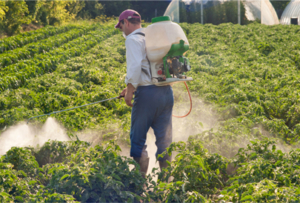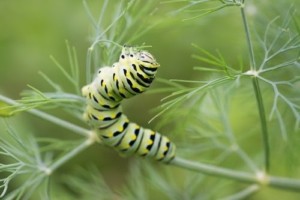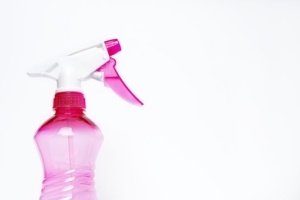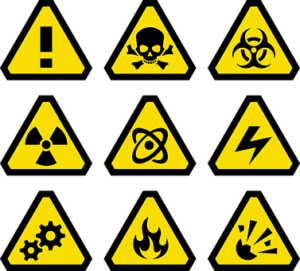Interiorscape Basics
Chapter Four: Integrated Pest Management
You will use a variety of methods to control pests in the interior environment. Integrated Pest Management (IPM) is the selection, integration and implementation of a pest control program that uses a variety of methods to control pest populations. IPM uses cultural, mechanical, biological and physical removal as the first lines of control. When using the IPM approach you will turn to pesticides as a last resort. You will instead choose the least toxic approach with thoughtful consideration for the surrounding environment.

An integrated approach to pest management is the best method
Biological Control
Biological control is an IPM that calls for using a living organism to control another less desirable living organism. The biological control agents (beneficials) are insect or mite predators or parasites.
On existing indoor plantings, the switch from chemical to biological controls takes careful planning and timing. Before introducing beneficials, toxic chemicals must not be present on plants. It may take a month or more for the long-term effects of the residual pesticides to wear off. During this time, pests can be kept in check with soap sprays, cultural controls and a few mild pesticides.
Regular plant inspections and monitoring go hand in hand with the use of biological controls. Once the beneficials are introduced in the environment, you must inspect and monitor both the pest and the beneficial population to verify that the beneficials are feeding. If the pest population exceeds the tolerable level, the beneficials must be reintroduced to the environment. The success of the program is measured by the rate of decline of the pest population.

Responsible pesticide usage means preserving beneficial insects
** Tidbit **
Using Beneficial Organisms
To use beneficial organisms effectively, consider the following factors:
- Beneficials are selective; no one beneficial will control all pests.
- Identify the pest to be controlled and correctly match the beneficial organism to the target pest.
- Beneficials are effective as long as there is food (target pests) available.
- Beneficials need to be applied to plants with each new infestation.
- Beneficials can be killed by accidental pesticide spraying.
- Use pesticides that will not harm beneficial organisms. Be aware of the plants that have biologicals on them.
- Beneficials are a living perishable product and must be purchased and used in a timely fashion.
- Keep records on your biological control program including beneficials used, successes and failures, and pesticide applications.
Cultural Controls
Cultural or mechanical controls refer to techniques used to change the plant’s physical environment, the condition of the host plant or the behavior of the pest in order to prevent or suppress the pest. Common cultural practices include aerating the soil, pruning diseased limbs, removing soluble salts, increasing humidity levels and changing watering or fertilization regimes. Other practices consist of isolating infected or infested plants, washing plants with soap, handpicking bugs, disinfecting tools and equipment and using sticky yellow cards to capture and monitor flying insects.
Environmental Stress Management

Are the interiorscape conditions optimal for healthy plants?
When establishing cultural practices, it is important to address environmental stresses that weaken the plant, physiological disorders such as imbalances in light, temperature, moisture and soil create conditions that make the plant susceptible to pathogens, insects and diseases. Cultural practices to modify the environment include protecting plants from heating or air conditioning vents; stabilizing temperatures by making seasonal adjustments; improving or maintaining the health of the plant with proper fertilizations, pH adjustments and moisture control.
Chemical Controls
Chemical controls rely on pesticides and the least toxic chemicals, such as rubbing alcohol and phosphate-free dish soap, to control infectious pests and microbes. In some instances, chemicals may be the best solution to a pest problem; in other cases, you may only want to use them when other options of pest control have failed. Chemicals used to destroy a pest or to protect a plant from a pest invasion are called pesticides or insecticides. There are two main chemical groups of pesticides: organic and inorganic compounds.
Organic insecticides contain carbon and other elements. When they are synthesized in a laboratory they are called synthetic organic insecticides. These are often extremely effective, easy to use and a relatively low cost to apply. Some are very specific in their activity. These pesticides are, however, the principal focus of health-related and environmental concerns because some are extremely toxic when used extensively or improperly. Inorganic compounds do not contain carbon and are of mineral origin (lead arsenate is an example).
The most widely used class of synthetic pesticides used today is the organophosphate (OP’s) type. They vary greatly in their toxicity and hazard to humans. They generally have a short residual life and do not accumulate in non-target organisms. Many of the most toxic insecticides belong to this group. Because they are more readily broken down in the environment, some of these insecticides are now being used to replace many of the more persistent chlorinated hydrocarbon insecticides.

Follow the pesticide instructions for safe use
Chlorinated hydrocarbons are the oldest major synthetic class of chemical pesticides. DDT was one of the first in this group. In general they are less toxic to humans than OP’s but they persist in the environment for long periods of time. Very few chlorinated hydrocarbons are registered for use today because of this. Other categories of synthetic organic pesticides are carbamates, pyrethroids and spray oils.
If chemical control is necessary, there are usually many options available to you. Products vary in a number of ways including efficacy, persistence, mobility, toxicity and mode of action. For example, insecticidal soap, a contact pesticide, must touch the pest to be effective.
When choosing a pesticide, read the label carefully. The label will tell you whether the pesticide is registered for use indoors and what pests the manufacturer claims the product will control. The label also lists plants that will not be harmed by application of the pesticide. Try to select a product that does not have an offensive odor or leave visible powdery residues on the foliage.
Be aware that you are required by law to follow all the directions on the label. Read it carefully. The label will tell you how to protect yourself and the environment when using the pesticide and how to mix, spray, dispose and store the pesticide. Never ignore the warning label!
- Wear goggles, rubber gloves and boots, inhaler and a pesticide resistant suit when handling restricted-use pesticides.
- Cover floors, rugs and surrounding areas with drop cloths or plastic sheets.
- Never mix or dispose of pesticides in sinks or areas where people mix or prepare food.
- Wipe up any spilled or dripped pesticide immediately and dispose of cleanup materials according to pesticide label directions.
- Wash hands thoroughly after applying a pesticide.
- Keep the pesticide concentrate in the original labeled container at all times.
Under federal law, only certified applicators may use restricted-use pesticides. Restricted-use pesticides are those classified by the Environmental Protection Agency (EPA) as harmful to humans, animals or the environment. When a pesticide is classified as restricted, the label states “Restricted Use Pesticide” in a box at the top of the front panel. Pesticides that are unclassified have no designation on the product label. Contact your state extension office for complete information about pesticide use and the legal requirements in your area.
Required warning words, signs and precautionary statements are mandatory on all labels. These are relative to the toxicity category of the pesticide formulation. Every pesticide must be labeled “Keep Out of Reach of Children.” Additional information required on the label tells of the environmental hazards and physical or chemical hazards. The label on the pesticide container serves as your guide to proper usage. Read the label carefully.
Signal Words and Precautionary Statements

Warning labels are meant to keep you and others safe
All pesticide labels carry a signal word – an indicator of how acutely toxic a substance is to humans. The signal word indicates the risk of poisoning from the four routes of entry your mouth, eyes, skin or inhalation.
Danger – Highly toxic
Warning – Moderately toxic
Caution – Slightly toxic
Safer’s Insecticidal Soap® carries a Caution signal word, while Enstar II® uses the signal word, Warning.
Read the label to find more information concerning a pesticide’s acute toxicity to the applicator and to surrounding non-target plants, people and fish. Domestic animals or wildlife may be harmed by contaminated runoff from improperly disposed leftover pesticide. Precautionary statements will warn you if you may be harmed by swallowing or inhaling the product or by getting it on your skin or in your eyes. Environmental hazards list precautions the applicator must heed to protect non-target people, plant and wildlife.
Least Toxic Pesticide
When cultural, mechanical and biological approaches to pest control do not work; an interiorscape-approved pesticide may be your next necessary step. Always use the least toxic pesticide that will get the job done. But, with all the different pesticide products on the market, how do you decide which one to choose? The first step is to narrow down your pesticide choices to pesticides that are legally allowed in your area for interiorscape use and that have both the plant to be treated and pest to be controlled listed on the label. Now look at the relative toxicity of each pesticide in relation to people, the target plant and the surrounding environment.
LD50
A common method of expressing a pesticide’s toxicity to humans is with the chemical’s LD50 rating. LD50 stands for the lethal dose of a pesticide that kills 50 percent of the lab animals used to test the chemical.
Four routes of entry (oral, dermal, ocular and inhalation) are tested and assigned an LD50. The rating is usually expressed in milligrams of poison per kilogram of body weight. The higher the LD50, the less toxic a substance; the lower the LD50, the more hazardous. For example, Safer’s Insecticidal Soap® has an oral LD50 of 5000+ and is less toxic than Enstar II® with an LD50 of around 1649. The pesticide manufacturer must provide the LD50 on all pesticides they sell. If not listed on the label, call the manufacturer and ask for a Material Safety Data Sheet (MSDS), which always will list the LD50.
** Tidbit **
The Keys to Integrated Pest Management
Keep your plants healthy in the interiorscape by following these IPM procedures:
- Choose healthy, acclimated and pest-free plant material.
- Provide the proper environment for the plant species.
- Use horticulturally correct maintenance procedures.
- Monitor plants closely for signs of infestation.
- Treat infestations with a combination of cultural, mechanical, biological and least toxic chemical solutions.
Pesticide Formulation
Pesticides come in different forms – such as liquids, powders, aerosols or other forms. Some formulations are more likely to harm surfaces, plants or people than others are. For example, emulsifiable concentrates can pit or stain surfaces, are easily absorbed through skin and may injure some plants. Dusts and powder are likely to leave a film or residue and may drift with air currents. Aerosols and fumigants are easily inhaled by a careless applicator.
Spend the time to learn about the pesticides you use and follow carefully all the precautions listed on the pesticide product label. Choose the least toxic product when you need to use a chemical pesticide. Know the relative acute toxic exposure hazards of some of the more common pesticides and what to do if an accident occurs. Before you spray, use your IPM training, always thinking through options that might control a pest population with other approaches than chemical control.
